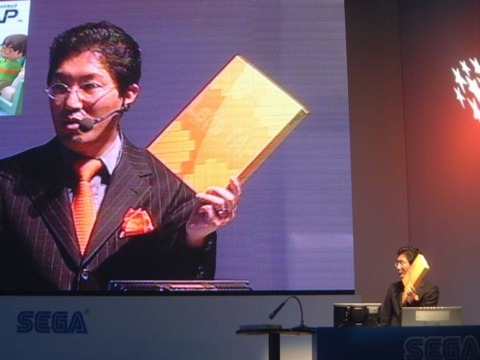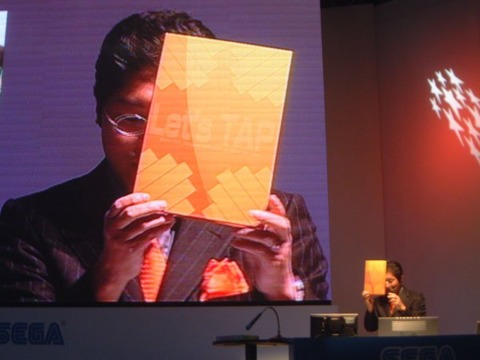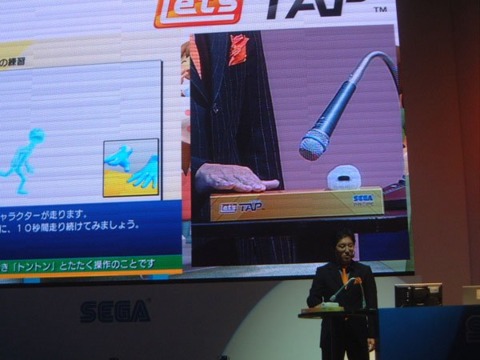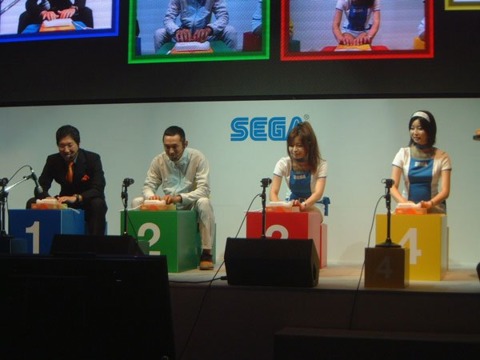Sonic creator taps out two catchy Wii titles
After two years of silence, former Sega producer and Sonic Team leader Yuji Naka unveils a pair of new projects: Let's Catch and Let's Tap.
TOKYO--It has been more than two years since Sonic creator and producer Yuji Naka left Sega to establish his own development studio, Prope. His activities have been completely unknown since then, but at the Tokyo Game Show this weekend, Naka finally unveiled his studio's debut titles, Let's Catch and Let's Tap.
"I left Sega in order to make some games I wanted, and after two years, I've created very fun games which I can finally show off to everyone," said Naka, as he went on to show his studio's two titles.
The first title introduced by Naka was Let's Catch for the Nintendo Wii, a Wiiware set for a December release in Japan. Costing 1,000 Nintendo points, Let's Catch was described as a game of catch where players use the Wii Remote to catch a ball and throw it back. The game makes use of the remote's built-in speaker and vibrator to simulate the real feel of a caught and thrown ball. As the player keeps catching, the ball speeds up until it goes beyond speeds possible for a human to throw. In a trailer shown to attendees, the ball reached up to 250 kilometers per hour (155.3mph) by the end, when the player was playing catch with an alien on another planet.
Let's Catch features a number of other minigames, such as hitting numbered panels on the screen with the ball. Up to four players can play together, and the trailer showed a family having fun playing.
Why make a simple game of catch? According to Naka, playing catch is one of the simple real-life games that has died out in Japan in recent years, and he's hoping to bring it back in video game form.
"Back when we were kids, we used to play catch with our fathers," explained Naka, emphasizing that Let's Catch is a family-oriented game. "But it's different for kids nowadays, because playgrounds and such places doesn't allow ball throwing any more. Playing catch was more than just about fun. It was also a form of communication. And you'd chat about things you normally wouldn't while you're playing, like 'How's stuff going?' and 'How was your test?' Nowadays, you don't have that kind of opportunity. So with this game, I hope to bring that back."
The second title introduced by Naka was also a Wii game, titled Let's Tap. "It's been 25 years since I've been making video games, but I believe this game is quite amazing," said Naka, as he took out a large orange box. As it turns out, the box was...just a box.
"Yes, it's just a box. This game uses boxes and allows you to play without the need of a controller," revealed Naka, who went on to demonstrate how the game is played.
As Naka demonstrated, Let's Tap is a collection of five minigames, and it's played by simply placing the Wii Remote upside down on top of a box. When the box is tapped, the remote's internal sensors will pick up the vibration and relay it to the video game as control input. Any kind of cardboard box, such as a Kleenex box, will apparently do.
"As you can see, just tapping on the box very lightly will even reflect in the game," explained Naka. "We've discovered that the Wiimote is very high-tech in terms of sensitivity, and it picks up even the most slightest movement." He then showed a stick figure running on the screen as he lightly tapped on the box numerous times with his fingers. He then showed that the remote could tell whether the taps were weak or strong. When he tapped the box with force, the stick figure jumped into the air instead of taking a step forward.
"Up until now, games were digital, made of zeros and ones," Naka continued. "But with this, the controls are very analog, and you can make weak and strong movements. It's a very enjoyable game, and everything is done by tapping." He then demonstrated that even the menu can be controlled by tapping.
After Naka's introduction, three guests appeared onstage to try out one of the minigames with him. They each played with a box that had a remote facing downward. Naka picked a game called Tap Runner, which played as a side-scrolling marathon game where stick figures ran and jumped in order to reach the goal line. There were various obstacles in the game, such as objects that would freeze characters for a short time if touched, ropes that needed to be carefully walked across with small taps, and big balloons that needed to be inflated with rapid taps so they would float players to their destinations.
After the demo, Naka continued his presentation and showed off the remaining four minigames featured in Let's Tap: Silent Blocks, Rhythm Tap, Bubble Voyager, and Visualizer. All four games make use of the strength-sensitive tapping mechanic, which reflects the force of a player's taps during gameplay.
Silent Blocks is a Jenga-like game that can be played with any number of players. The players take turns pulling out pieces from a tower without making it fall. There is also a puzzle-game mode in Silent Blocks, where the pieces disappear when three or more of the same color end up stacked together. The player gets additional points by erasing pieces through a chain reaction. The puzzle mode lets up to four players play against one another.
Rhythm Tap looked like a relatively standard music game, albeit with a slight twist. Targets scroll from right to left, and the player needs to tap at just the right moment to get a score. But unlike in a typical music game, there are three types of markers that indicate whether the player needs to tap weak, medium, or strong. Roughly 20 music tracks are included, and up to four players can play together.
Bubble Voyager is a side-scrolling shooting game with a somewhat retro feel. By tapping, players can float their character in the air, and the objective is to avoid obstacles and collect items while advancing through the stage. Tapping strongly will allow the character to shoot missiles, erasing obstacles in the path. The game seemed to play similarly to the Balloon Trip mode in Nintendo's 1985 classic NES title Balloon Fight.
In four-player mode, Bubble Voyager plays quite differently and features a bird's-eye-view perspective. From the short clips shown at the presentation, the mode seemed to play similarly to Atari's classic Asteroids.
Last but not least, the Visualizer is a collection of interactive computer-generated visuals, kind of like high-quality screensavers. Naka commented that this mode requires no gaming experience, and anyone from a 1-year-old to a 100-year-old can play it.
"If you give a video game controller to an elderly person, typically they wouldn't be sure what to do," said Naka. "But if you ask them to just tap on a box, it's very simple. It's so simple that even a penguin could play it."
Let's Tap will be released in Japan this December and will come with two large boxes, making its package much larger than a normal game. "You'll feel like you've got a great deal when you buy it," joked Naka about the package's size.
"Up until now, games have been digital, and I think this is a really big change that input strength can be read. At our office, we're thinking that 'Pre-Let's Tap' and 'Post-Let's Tap' may become [game industry] terms," declared Naka, winding up his presentation. "I'm hoping that in the future, there will be game hardware that can detect physical strength. Humans can adjust their movement very sensitively. We've been able to make that reflect on our game well, and I think it's really enjoyable. We at Prope will continue to make these kinds of fun games together with Sega."
Got a news tip or want to contact us directly? Email news@gamespot.com




Join the conversation